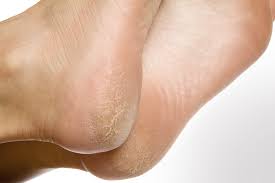1. Heel balms or thick moisturizers
The first line of treatment for cracked heels is using a heel balm. These balms contain ingredients to moisturize, soften, and exfoliate dead skin. Look out for the following ingredients:
urea (Flexitol Heel Balm)
salicylic acid (Kerasal)
alpha-hydroxy acids (Amlactin)
saccharide isomerate
You can find these heel balms over the counter at a drug store or online.
Tips for treating cracked heels
apply heel balm in the morning to increase skin elasticity before you start your day
moisturize your heel two to three times a day
wear shoes that protect your heel
Some heel balms may cause minor stinging or irritation. This is normal. Consult your doctor if the balm continues to bother you or causes severe reactions. Severe cases of cracked heels may require a prescription-strength balm or steroid cream to help reduce inflammation and relieve itching.
2. Soak and exfoliate your feet
The skin around cracked heels is often thicker and drier than the rest of your skin. This skin tends to split when you apply pressure. Soaking and moisturizing your feet can help with this. Here are some tips.
For a foot soak:
Keep your feet in lukewarm, soapy water for up to 20 minutes.
Use a loofah, foot scrubber, or pumice stone to remove any hard, thick skin.
Gently pat your feet dry.
Apply a heel balm or thick moisturizer to the affected area.
Apply petroleum jelly over your feet to lock in moisture. Put on socks to avoid spreading any grease around.
Avoid scrubbing your feet when they’re dry. This increases your risk for damaged skin.
You can also try moisturizing heel sleeves. These have a similar effect to foot soaks. The sleeves are like socks that contain therapeutic oils and vitamins to help treat your dry skin. You can find them on Amazon here.
3. Liquid bandage
You can also apply liquid bandage to cracks to seal the wound and prevent infections or further cracking. This product comes as a spray, which means you can go about your day without worrying about the bandage coming off. Liquid bandage is a good option for treating deep heel cracks that may bleed.
Apply liquid bandage to clean, dry skin. As the crack heals, the coating is forced to the skin’s surface. You can buy this product without a prescription at a drug store or online on Amazon.
Some people report success using super glue to close skin cracks. One 1999 case study observed ten people who used two to three drops of super glue along each crack. They held the crack together for 60 seconds to allow it to seal. About a week later, they reported the cracks to be closed and pain-free. But commercial super glue can be toxic, depending on the brand. Talk to your doctor before trying this approach.
4. Honey
Honey may work as a natural remedy for cracked heels. According to a 2012 review, honey has antimicrobial and antibacterial properties. Research shows that honey can help heal and cleanse wounds, and moisturize the skin. You can use honey as a foot scrub after a soak, or apply it as a foot mask overnight.
5. Coconut oil
Coconut oil is often recommended for dry skin, eczema, and psoriasis. It can help your skin retain moisture. Using coconut oil after a foot soak could be a good option, too. Coconut oil’s anti-inflammatory and antimicrobial properties may your cracked heels if they’re prone to bleeding or infections.



 Contact Us
Contact Us







 Hospitals
Hospitals
 Doctors
Doctors
 Diagnostic
Diagnostic
 Pharmacy
Pharmacy
 Health Tips
Health Tips
 Blog
Blog

























Comments